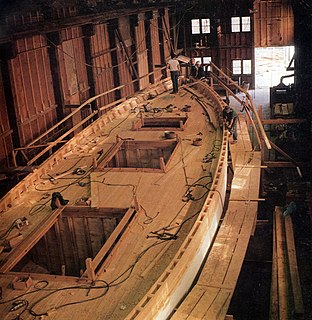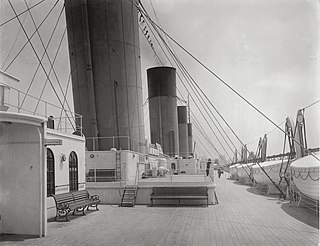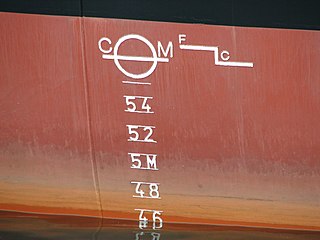Related Research Articles

Vasa or Wasa is a Swedish warship built between 1626 and 1628. The ship sank after sailing roughly 1,300 m into her maiden voyage on 10 August 1628. She fell into obscurity after most of her valuable bronze cannon were salvaged in the 17th century, until she was located again in the late 1950s in a busy shipping area in Stockholm harbour. The ship was salvaged with a largely intact hull in 1961. She was housed in a temporary museum called Wasavarvet until 1988 and then moved permanently to the Vasa Museum in the Royal National City Park in Stockholm. The ship is one of Sweden's most popular tourist attractions and has been seen by over 35 million visitors since 1961. Since her recovery, Vasa has become a widely recognised symbol of the Swedish Empire.

Boat building is the design and construction of boats and their systems. This includes at a minimum a hull, with propulsion, mechanical, navigation, safety and other systems as a craft requires.

A deck is a permanent covering over a compartment or a hull of a ship. On a boat or ship, the primary or upper deck is the horizontal structure that forms the "roof" of the hull, strengthening it and serving as the primary working surface. Vessels often have more than one level both within the hull and in the superstructure above the primary deck, similar to the floors of a multi-storey building, that are also referred to as decks, as are certain compartments and decks built over specific areas of the superstructure. Decks for some purposes have specific names.
A joist is a horizontal structural member used in framing to span an open space, often between beams that subsequently transfer loads to vertical members. When incorporated into a floor framing system, joists serve to provide stiffness to the subfloor sheathing, allowing it to function as a horizontal diaphragm. Joists are often doubled or tripled, placed side by side, where conditions warrant, such as where wall partitions require support.
This is a glossary of nautical terms; some remain current, while many date from the 17th to 19th centuries. See also Wiktionary's nautical terms, Category:Nautical terms, and Nautical metaphors in English. See the Further reading section for additional words and references.

Clinker built is a method of boat building where the edges of hull planks overlap each other. Where necessary in larger craft, shorter planks can be joined end to end into a longer strake or hull plank. The technique developed in northern Europe and was successfully used by the Anglo-Saxons, Frisians, Scandinavians, and typical for the Hanseatic cog. A contrasting method, where plank edges are butted smoothly seam to seam, is known as carvel construction.

The waterline is the line where the hull of a ship meets the surface of the water. Specifically, it is also the name of a special marking, also known as an international load line, Plimsoll line and water line, that indicates the draft of the ship and the legal limit to which a ship may be loaded for specific water types and temperatures in order to safely maintain buoyancy, particularly with regard to the hazard of waves that may arise. Varying water temperatures will affect a ship's draft, because warm water is less dense than cold water, providing less buoyancy. In the same way, fresh water is less dense than salinated or seawater with the same lessening effect upon buoyancy.

The bow is the forward part of the hull of a ship or boat, the point that is usually most forward when the vessel is underway. The aft end of the boat is the stern.

Endurance was the three-masted barquentine in which Sir Ernest Shackleton and a crew of 27 men and one cat sailed for the Antarctic on the 1914–1917 Imperial Trans-Antarctic Expedition. She was launched in 1912 from Sandefjord in Norway; three years later, she was crushed by pack ice and sank in the Weddell Sea off Antarctica. All of her crew survived.

The beam of a ship is its width at its widest point. The maximum beam (BMAX) is the distance between planes passing through the outer extremeties of the ship, beam of the hull (BH) only includes permanently fixed parts of the hull, and beam at waterline (BWL) is the maximum width where the hull intersects the surface of the water.
Shoring is the process of temporarily supporting a building, vessel, structure, or trench with shores (props) when in danger of collapse or during repairs or alterations. Shoring comes from shore, a timber or metal prop. Shoring may be vertical, angled, or horizontal.

A king post is a central vertical post used in architectural or bridge designs, working in tension to support a beam below from a truss apex above.
Builder's Old Measurement is the method used in England from approximately 1650 to 1849 for calculating the cargo capacity of a ship. It is a volumetric measurement of cubic capacity. It estimated the tonnage of a ship based on length and maximum beam. It is expressed in "tons burden", and abbreviated "tons bm".

Fullers Bridge, officially called the Fullers Creek Bridge, is a road bridge that carries Delhi Road to Millwood Avenue across the Lane Cove River, in Chatswood West, Sydney, New South Wales, Australia. The concrete beam bridge is located 9 kilometres (5.6 mi) northwest of the Sydney central business district and connects Chatswood to North Ryde as part of the A38.

The stern is the back or aft-most part of a ship or boat, technically defined as the area built up over the sternpost, extending upwards from the counter rail to the taffrail. The stern lies opposite the bow, the foremost part of a ship. Originally, the term only referred to the aft port section of the ship, but eventually came to refer to the entire back of a vessel. The stern end of a ship is indicated with a white navigation light at night.
The 1719 Establishment was a set of mandatory requirements governing the construction of all Royal Navy warships capable of carrying more than 20 naval long guns. It was designed to bring economies of scale through uniform vessel design, and ensure a degree of certainty about vessel capability once at sea, and was applied to all vessels from the first-rate to the fifth-rate. Once in effect, it superseded the 1706 Establishment, which had specified major dimensions for ships of the second-rate, third-rate and fourth-rate only.

In ships, frames are ribs that are transverse bolted or welded to the keel. Frames support the hull and give the ship its shape and strength.

The Sparrow-Hawk was a 'small pinnace' similar to the full-rigged pinnace Virginia that sailed for the English Colonies in June 1626. She is notable as the earliest ship known from the first decades of English settlement in the New World to have survived to the present day.
Longitudinal framing is a method of ship construction in which large, widely spaced transverse frames are used in conjunction with light, closely spaced longitudinal members. This method, Isherwood felt, lent a ship much greater longitudinal strength than in ships built in the traditional method, where a series of transverse frames were fit together closely from the keel upwards.

Mirosa is a Thames barge which was built in 1892. From 1892 until 1947, she sailed under the name Ready when the name was sold to Trinity House for a lightship support vessel. Under her new name, she traded until 1955. Mirosa has never had an engine.
References
![]() This article incorporates text from a publication now in the public domain : Chambers, Ephraim, ed. (1728). Cyclopædia, or an Universal Dictionary of Arts and Sciences (1st ed.). James and John Knapton, et al.Missing or empty
This article incorporates text from a publication now in the public domain : Chambers, Ephraim, ed. (1728). Cyclopædia, or an Universal Dictionary of Arts and Sciences (1st ed.). James and John Knapton, et al.Missing or empty |title= (help)